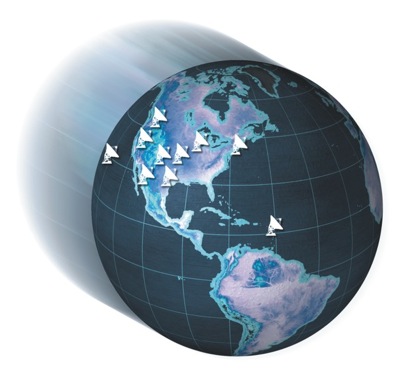
Record-breaking radio astronomy project
DR EMILY BALDWIN
ASTRONOMY NOW
Posted: November 17, 2009


This week, 35 of the world's greatest radio telescopes will join forces to observe 243 distant quasars to precision map the reference frame scientists use to measure positions in the sky.
 The new reference frame for celestial positions will be anchored by 295 distant quasars, 243 of which will be observed in the upcoming campaign. Image: NASA/JPL-Caltech. The new reference frame for celestial positions will be anchored by 295 distant quasars, 243 of which will be observed in the upcoming campaign. Image: NASA/JPL-Caltech.
The record-breaking feat will begin on Wednesday and last 24 hours. Quasars – galaxies with supermassive black holes at their cores – are profuse emitters of radio waves, and are so distant that despite their actual motions in space, they appear stationary as seen from Earth. This makes them ideal celestial landmarks for anchoring a grid system, similar to Earth's latitude and longitude.
The study will combine the observing power of 35 radio telescopes from Asia, Australia, Europe, North America, South America, Antarctica, and the Pacific – a technique known as long baseline interferometry (VLBI) – to obtain high precision data. While VLBI is not a new technique, no previous position-measuring observation has used as many radio telescopes (the previous record was 23) or observed as many objects in a single session.
Last August the International Astronomical Union adopted a new reference frame for celestial positions that will be put into practice on 1 January. This framework is based on 295 quasars, and even with 35 telescopes on the case, there are still some gaps in sky coverage, meaning that 243 will be observed in the upcoming study period.
 The continent-wide Very Long Baseline Array (VLBA) is participating in the project. Image: NRAO/AUI. The continent-wide Very Long Baseline Array (VLBA) is participating in the project. Image: NRAO/AUI.
The observation campaign will yield a much stronger and more precise reference than ever before, allowing astronomers to better pinpoint the locations and measure the motions of objects in the sky. The improved positions will also facilitate more accurate matching up of observations of the same object made by different telescopes and at a range of wavelengths.
The improved celestial reference frame also strengthens a terrestrial reference frame used for radio-telescope measurements that contribute to geophysical research, such as the study of plate tectonics, Earth tides, and processes that affect our planet’s orientation in space.
The multi-telescope observation will be accompanied by public-outreach activities in celebration of the International Year of Astronomy. A public web page devoted to the observation will be hosted at Bordeaux Observatory, and some of the participating telescopes will have webcams available.
|



